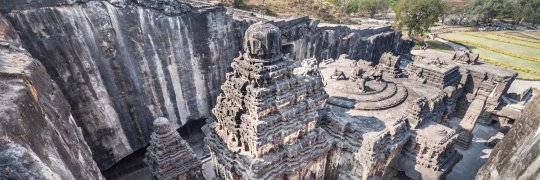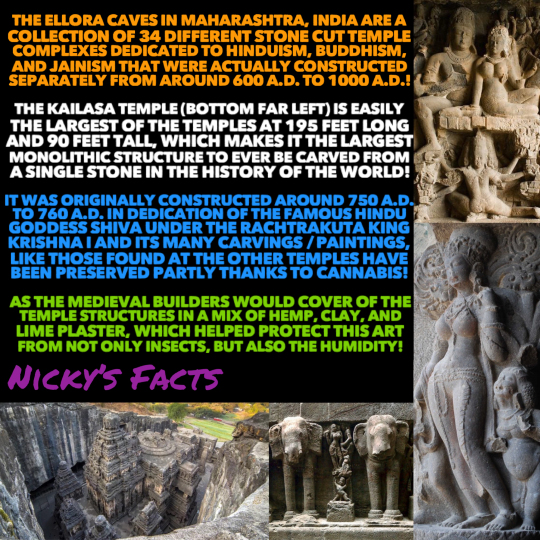#Ellora Caves
Explore tagged Tumblr posts
Text

The Kailasa temple in Maharashtra India is a rock cut temple (one of many) and this one in particular is carved out of one single rockspace. It is in fact the largest rock cut (a whole Indian style) one out of the thirty-four in Ellora Caves -Just the grandeur, skill, and size of all this is awing.
Peak of Indian rock cut architecture.
#architecture#indian architecture#indian inspired#kailasa#kailasa temple#Maharashtra#india temple#rock temple#temples#ellora caves#how cool is that#how cool is this#rock architecture#carved architecture#india#indian culture#indian
32 notes
·
View notes
Text

Ellora Caves
Shiva as Kala Bhairava with flaming eyes and in a state of frenzied excitement, with the Saptamatrika at his feet.
#ellora#ajanta ellora caves#UNESCO#UNESCO World Heritage Sites#Ellora Caves#Shiva#Kala Bhairava#Mahadev#Hinduism#Hindu#Ancient Bharat#Scriptures#Scripture#Carving#Statue#Ancient#Acient Hindu#Kailash Temple
105 notes
·
View notes
Text
Unveiling the Marvel of Kailasa Temple, Ellora Caves!

Carved from a single rock, the Kailasa Temple in Ellora is an architectural wonder that defies time and logic. This 8th-century masterpiece stands as a testament to ancient India's engineering brilliance and spiritual devotion. Every intricate detail tells a story of artistry and dedication.
🗿 One Rock. Infinite Stories. 📍 Location: Ellora Caves, Maharashtra, India 📜 A symbol of devotion to Lord Shiva
Discover the mysteries behind this timeless creation! 🔍👇 🔗 Read More Here
#ellora caves#lord shiva#historic#archetecture#ancient architecture#incredibleindia#travel#historic places#culturalheritage#mystery#mysteryunveiled
2 notes
·
View notes
Text

You could say that the builders of these beautiful temples at the Ellora caves were huge stoners!😂
☸️🇮🇳🕉️
#history#ellora caves#maharashtra#kailasa temple#art#indian history#landmarks#medieval#architecture#stone#monolithic structure#hemp#medieval india#art history#travel girl#cannibus#shiva#hinduism#buddhism#jainism#beautiful#architectural history#india#wonder of the world#temples#medieval art#nickys facts
15 notes
·
View notes
Text

The Ellora Caves are a cave complex with monolithic temples in India. Amazing that entire temples were carved out of a single rock...also a Unesco heritage site.
⛲️⛲️⛲️
#anime#ufos#aliens#scifi#extraterrestrials#animation#ancient aliens#comic books#fantasy#manga#ellora caves#india#temples
5 notes
·
View notes
Text

#saibabateachings#saibabaquotes#saibabablessings#saibabashirdi#saibabamiracles#saibaba#shirditour#saibabatemple#Shirdi#shirditrip#shirdisai#shirdisaibabatemple#shirdidarshan#shirdibaba#shirdipackages#shirdisaibabamessage#shirdiyatra#shirdisaibaba#ShirdiLiveDarshan#shirdisaibabablessings#saibabaofshirdi#shirdiwalesaibaba#saimiracles#saibabamessage#saitemple#OmSaiRam#shirditourpackage#shirdiflightpackage#ellora caves#ellora
0 notes
Text

https://sainamam.com/shirdi-flight-package-from-chennai.html
#saibabateachings#saibabaquotes#saibabablessings#saibabashirdi#saibabamiracles#saibaba#shirditour#saibabatemple#Shirdi#shirditrip#shirdisai#shirdisaibabatemple#shirdidarshan#shirdibaba#shirdipackages#shirdisaibabamessage#shirdiyatra#shirdisaibaba#ShirdiLiveDarshan#shirdisaibabablessings#saibabaofshirdi#shirdiwalesaibaba#saimiracles#saibabamessage#saitemple#OmSaiRam#shirditourpackage#shirdiflightpackage#ellora caves#ellora
0 notes
Text
Ellora Caves
The next day, we went to the Ellora caves, another series of rock-cut temples and monasteries, but a quite different experience.
The caves are a mix of Buddhist, Hindu, and Jain styles, with significant differences in style. Although the complex has over 100 caves, only 30 are open to the public, which is still too much for one day if you have to drive there.
Thankfully, the roads were in much better condition than the day before.
The first site you see from the entrance is the Kailasha Temple, which is not actually a cave but an entire three-dimensional temple carved from solid rock. It's the largest monolithic construction in the world.



The Kailasa Temple represents the sacred mountain of Shiva and is dedicated to him. The temple has rooms and corridors within it.

Construction of the Kailasa Temple is believed to have taken place between 757 and 783 AD. During this period, over 200,000 tons of rock were excavated out of the basalt to form the magnificent temple, which was carved from top to bottom with only simple hammers and chisels.
The surfaces of the entire temple are covered with sculptures. For a start, it is carved to depict the temple standing on the backs of rows of elephants.


But there are depictions of other animals, gods, battles and more.



The interior rooms are large.



The center contains a large lingam, a votary object that symbolizes the god Shiva and is revered as an emblem of generative power.

It really is an amazing structure. But while carving it from solid rock is an amazing feat, traditional construction would probably have been more work, as individual blocks would need to be cut, transported, assembled, and then carved. With hammers and chisels, carving stone blocks from bedrock creates a lot of waste. Creating the open spaces within the temple would also be challenging.
The other caves in the complex are also impressive. There are vast multi-story complexes.

Each floor has a large central hall surrounded by smaller cells. There are carvings everywhere on the interior.


As you move further into the interior spaces, it becomes darker and darker, as no artificial lighting has been added.

At the back of the top floor was this closed door. Behind the grill, we could see a magnificent Buddha. The head of the Buddha is just visible above the top of the door!

As we peered through the mesh, a guard came to unlock the door. Inside, the gloom was almost total.
The low light robbed the images of all color in photos.

As we were looking at the Buddha, someone turned their flashlight on a side wall of the chamber, and there, in the darkness, were taller-than-lifesize statues of other deities. It felt like being on an expedition into the unknown. These photos were taken with only the lights from our phones. Without those lights, we would have stood directly in front of the statues and never even known they were there.


On the other side were yet more statues.

I would love to have seen these in more light, but the experience in the dark was amazing.
The next location was a worship hall with a large stupa at the back, but here there was also a Buddha statue on the front of the stupa.


Above the entrance was a second story, like a choir loft which allowed more light into the chamber.

While there were more temples in the Buddhist area, we headed to the far end of the complex to the Jain temples. The Jains are not well known in the West. They date to the same era as the Buddha and are more extreme in their views. They are strict vegetarians, to the point that they will wear masks to prevent inhaling insects and won't eat root vegetables because harvesting them might disturb insects in the soil. There are two branches of the faith; one only wears white clothes, and the other wears no clothes at all.
Their religious beliefs severely restrict their occupations; for instance, they can't farm. As a result, many of them went into jewelry and have become quite wealthy. (I expect those operating jewelry stores to be of the clothes-wearing branch.)
Their temples were some of the most interesting ones we visited, with some of the most intricate carvings.

They believe in stillness, and one common image is of a man who has stood so still that vines are winding around him.


The large halls had intricately and uniquely carved columns.


With that, I have reached my limit on images in a post. It was a location with impressive structures and carvings in various unique styles. This alone would have made for amazing day, but there was more, in the next post!
0 notes
Text
Discover Top Places to Visit in Aurangabad
Discover Aurangabad: India's Hidden Gem Explore the wonders of Aurangabad, India! From ancient Ajanta Caves to the majestic Bibi Ka Maqbara, this city is a treasure trove of history and culture. Plan your perfect getaway with our guide to the top places to visit in Aurangabad. #AurangabadTourism #TravelIndia #ExploreHistory
Aurangabad is a city full of history, amazing buildings, and culture. It has the Ajanta Caves, with 30 ancient rock-cut structures from the 2nd Century. There’s also the Bibi Ka Maqbara, a Mughal-era wonder. Travelers can see ancient structures, marvel at carvings and paintings, and feel the city’s timeless charm. Discover the best places to visit in Aurangabad. Bibi_ka_Maqbara by…
#Ajanta Caves#Ajanta Ellora caves visit#aurangabad places to see#aurangabad sightseeing places#aurangabad tourist attractions#aurangabad tourist places#aurangabad tourist point#aurangabad visit#Bibi Ka Maqbara#Daulatabad Fort#Ellora Caves#places aurangabad#places of interest in aurangabad#places to go in aurangabad#places to roam in aurangabad#places to see at aurangabad#places to see in aurangabad maharashtra#places to visit aurangabad maharashtra#places to visit in aurangabad#places to visit in aurangabad city#tourist places to visit in aurangabad
0 notes
Text
Ellora Caves a Marvel of Indian Architecture 2024
Ellora Caves: A Marvel of Indian Architecture
Introduction
The history of India is very rich in itself. India’s historical heritage with its cultural and artistic Known for all over the world. One of these Ellora caves in Maharashtra has its own It has a rich history inside it. Ellora caves are known for their religious diversity. The architecture and painting of Ellora Cave is very attractive.

Ellora Caves have been included in the world’s historical heritage by UNESCO. Tourists coming from far and wide around the world they feel thrilled to come here. The number of foreign tourists visiting Ellora and Ajanta caves is increasing year after year. Next, we will learn about the history, art and religious importance of Ellora caves, and Indian culture.
Ellora Caves: History and Origin
Ellora caves are also near the Ajanta caves in Aurangabad, Maharashtra. These caves were constructed between the sixth and tenth centuries by cutting rocks. These caves are also historically important because it is a unique blend of caves of Hindu, Buddhist, and Jain religions. The Ellora caves are a portrayal of the artistic and religious progress of ancient India.

These caves were built during the reign of the rulers of Wakataka and Rashtrakuta dynasty. The caves of Ellora are well carved by cutting large stones. Thirty-four caves of Ellora are famous. Within these 34 caves, 12 caves belong to Buddhism, 17 caves belong to Hinduism and five to Jainism. Made by cutting huge rocks, these caves are a masterpiece in themselves. These caves, made by cutting huge rocks, present an excellent piece of art in themselves.
Architecture of Ellora Caves
Known for their unique craftsmanship, the caves of Ellora hold a significant place in history. Here religious stories are portrayed in paintings and sculptures. The most famous of these caves is the Kailash Temple which is located in number sixteen. The Kailash Temple was constructed during the worship of Lord Shiva. This temple is dedicated to Lord Shiva.
It is one of the biggest single rock formations in the world. During the construction of the Kailash Temple, it was constructed by cutting 18,000 tons of rocks. The architecture of Kailash Temple is phenomenal. The Kailash Temple’s most notable feature is that it is entirely carved.
The main points of interest are its elaborate sculpture, the statues of Shiva and Parvati, and the scene where Ravana raises Mount Kailash. Paintings and sculptures are carved in these caves in such a way that they are seen presenting living examples. Such wonderful paintings and artworks are not found anywhere else in the world.
Religious significance
Ellora caves are of great importance religiously. These caves symbolize the unity of Hinduism, Buddhism and Jainism. Despite different religions, the center of everyone’s faith is the same. Such diversity at one location is a sign of religious harmony and tolerance.
Buddhist Caves
There are Chaityas (Stupas) and Viharas (monasteries) in the Buddhist caves of Ellora. In this, a cave whose number is 10 is also called Vishwakarma cave. It is one of the most famous of the Buddhist caves. Just inside it is a giant statue of Lord Buddha in which he is sitting in meditation posture. The Buddhist teachings and beliefs are conveyed through the paintings and sculptures in this place.

Hindu Caves
The most significant Hindu cave is the Kailash Temple, but other caves also have images of gods and goddesses and scenes from sacred narratives etched on them. The events of the Ramayana and Mahabharata are portrayed in Cave No. 14, also known as the “Ravana Ki Khaai.” This collection of sculptures demonstrates the breadth and depth of Indian religious art.
Jain Caves
Jain caves also have a history inside them. The caves 32 and 34 stand out among them. The sculptures of Jain Tirthankaras adorn these caves. The subtleties and details in the sculpture of the Jain caves, which convey the Jain philosophy of non-violence and self-control, have received particular attention.
Tourism and Cultural Significance: One of India’s main tourist destinations is the Ellora caves. Millions of visitors come here from all over the world. The caves are a unique tourist destination because of their distinctive architecture, religious significance, and cultural legacy. The depth of Indian history and art leaves a lasting impression on visitors.

The Ellora caves are also a representation of the preservation of Indian cultural heritage. The site serves as an example of bringing together different facets of Indian culture, and the art and architecture here attest to the flourishing of Indian civilization.
conclusion
The Ellora caves offer exceptional illustrations of Indian architectural design, religious acceptance, and cultural legacy. The ancient Indian society’s religious beliefs and cultural values are portrayed vividly in the sculptures found here.
click here
0 notes
Text
Aurangabad Travel Guide: From Getting There to Must-Visit Attractions
Aurangabad, Maharashtra - blend of history, culture, and culinary delights.
Welcome, fellow wanderer! If you’re seeking a destination that seamlessly blends ancient heritage with vibrant culture, look no further than Aurangabad. Nestled in the heart of Maharashtra, India, this city invites you to step back in time, explore captivating monuments, and savor delectable local flavors. Let’s embark on an adventure together! Getting There From Panvel If you’re starting your…

View On WordPress
#Ajanta Caves#Aurangabad#Bakarwadi#culture#Ellora Caves#history#india#maharashtra#Naan Qalia#Paithani Sarees#panvel#Puran Poli#thepanvelite#Travel
0 notes
Text

KAILASA TEMPLE (Kailasha or Kailashanatha Temple) is the largest rock-cut Hindu temples at the Ellora Caves in Verul, Maharashtra, INDIA
160 notes
·
View notes
Text

Chaitya Hall in the Ellora Caves, Aurangabad, India
British vintage postcard
#vintage#British#postkaart#sepia#ephemera#postcard#postal#Aurangabad#postkarte#historic#briefkaart#Caves#Hall#tarjeta#India#photography#ansichtskarte#Chaitya#photo#Ellora#carte postale
7 notes
·
View notes
Text

women
7 notes
·
View notes
Text
Can’t wait to see this face in da4

3 notes
·
View notes
Text


Just some classic mid-2000s digital books with Poser covers.
So shiny. So round. So creepy.
4 notes
·
View notes